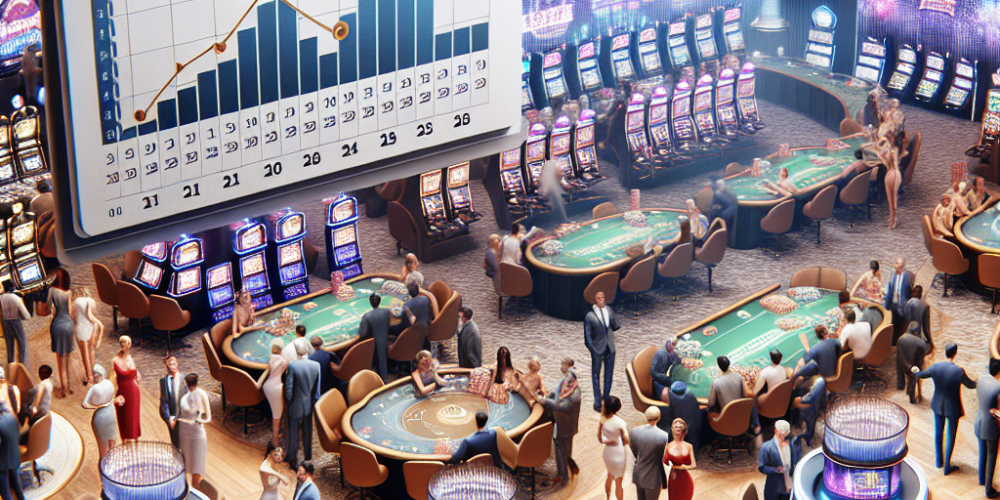In August, casino attendance in the United States continued to face challenges, with visitations declining by 5.4% compared to the previous month and dropping sharply by 17.5% from pre-pandemic levels. This data, provided by Jefferies Equity Research and analyst David Katz, highlights ongoing difficulties for the industry despite some positive developments.
According to Katz, while unemployment rates in the sector have shown improvement, the dip in casino attendance remains a significant concern. The decline in foot traffic persisted in August, aligning with previous forecasts, yet offered a slight uptick compared to July, which had experienced a steeper fall. Despite fewer visitors, casinos have managed to maintain a steady increase in gross gaming revenue since late spring, indicating that fewer attendees do not necessarily translate to lower profits.
Certain states have emerged as beacons of hope for the industry, contributing to positive outcomes nationwide. For instance, Churchill Downs’ The Rose in Virginia and Penn Entertainment’s Hollywood Joliet have opened their doors, attracting visitors and enhancing overall results. Pennsylvania stood out as an exception, recording an impressive 18.8% growth compared to 2019. In contrast, Illinois and New Jersey experienced notable declines in their casino performance.
Katz remarked that the mixed results reflect a volatile journey toward normalizing traffic trends post-COVID, influenced by intensified competition and renovations in specific areas. The analyst cautioned against relying solely on Las Vegas and Nevada as benchmarks, suggesting that regional gambling is poised for growth even as these traditional hubs face slowdown and stagnation.
The industry is not without its challenges, yet there are reasons for cautious optimism. Katz predicts that by the last trimester of the year, Las Vegas may exhibit signs of recovery, dispelling some of the current pessimism. He emphasized that while the numbers appear less than ideal, the slump seems temporary, with recovery on the horizon.
Apart from regional performances, several factors contribute to the complexities of the current casino landscape. The pandemic-induced shift in consumer behavior, where people developed new entertainment preferences, plays a role in the fluctuating attendance figures. Moreover, economic uncertainties and inflationary pressures might deter some potential visitors from spending as freely as before.
Nevertheless, not everyone shares the same gloomy outlook. Some industry experts argue that the current downturn is simply a transitional phase. They believe technological innovations and enhanced customer experiences will eventually draw people back to casinos in droves. With the rise of online gambling platforms, traditional establishments might face challenges, but also opportunities to integrate digital and physical offerings to captivate a broader audience.
Moreover, the introduction of new gaming options and diversified entertainment experiences at casinos may attract a different demographic, potentially offsetting the decline in traditional visitation rates. As casinos adapt to evolving consumer preferences, they may find new pathways to success.
While the road to recovery may not be entirely smooth, the casino industry’s adaptability and resilience are noteworthy. The ability to pivot and embrace new trends could enable casinos to emerge stronger in the long run. The current lull may serve as a catalyst for innovation and growth, ultimately benefiting the industry as a whole.
In conclusion, while casino attendance in the United States remains troubled, the overall outlook is not entirely bleak. With regional markets showing promise and revenue figures on an upward trajectory, the industry is positioned for eventual recovery. The path may be fraught with challenges, but there is confidence that the industry will navigate them successfully and continue to thrive in the future.

David Harrison stands tall in gambling journalism, marrying his firsthand casino experiences with a deep understanding of betting psychology. His articles transform complex gambling jargon into engaging tales of strategy and chance, making the world of betting accessible and enjoyable. David’s knack for narrative extends beyond print, making him a sought-after speaker on gambling trends and future bets. In the realm of gambling, David is both a scholar and a storyteller, captivating readers and listeners alike.
















